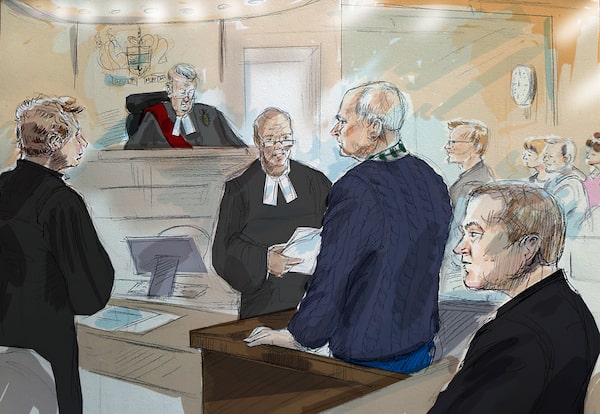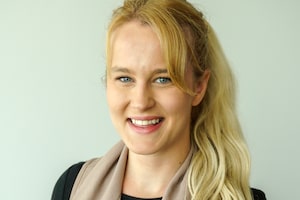Warning: This story contains graphic details
Dean Lisowick’s daughter, Emily Bourgeois, never met her father. But she held on to the possibility that one day, things could change. “There was still a chance that one day I’d be able to meet him,” Ms. Bourgeois wrote in a statement, read before a Toronto court on Monday. But that chance was ripped away when her 43-year-old father was murdered by serial killer Bruce McArthur.
“He was taken away from the world, and never got a chance to right his wrongs,” she said.
Monday was the first day of a sentencing hearing for Mr. McArthur. The 67-year-old landscaper pleaded guilty to eight charges of first-degree murder last week. Friends and family of his victims over nearly a decade − Skandaraj Navaratnam, Majeed Kayhan, Abdulbasir Faizi, Soroush Mahmudi, Kirushna Kumar Kanagaratnam, Mr. Lisowick, Selim Esen and Andrew Kinsman − were given a chance to address their loved ones' killer face to face. Mr. McArthur sat silently as statements were read.
Memories of the slain men spilled out from the witness box, from Mr. Navaratnam’s indomitable Scrabble skills and knowledge of tropical fish to Mr. Kinsman’s habit of inviting a friend to chat on their roof, saying, as Meaghan Marian recalled, “Now, I just have 10 minutes, but…” An hour and a half later, they’d be caught up in gossip or “political rantings” as the sun dipped below the horizon.

Defence lawyer James Miglin, left to right, Justice John McMahon, court registrar, Bruce McArthur, Crown Attorney Michael Cantlon, Detective Hank Idsinga, and friends and family of victims, back right, are shown in this court sketch in Toronto on Jan. 29, 2019.Alexandra Newbould/The Canadian Press
In depth: The eight lives taken from Toronto’s Gay Village
Opinion: McArthur victims remembered in emotional testimony
The painful aftershocks of Mr. McArthur’s crimes were also laid bare. Friends and family described fitful nights of sleeplessness and nightmares. Some turned to alcohol. Others took time off work to deal with stress, grief and lingering questions. Disagreements were left hanging when friends disappeared abruptly. “I always knew that one day we would resolve it. I thought we had time,” Adrian Betts, a friend of Mr. Kinsman’s, said of a falling-out between them. Mr. Betts had known Mr. McArthur, too, and bitterly recalled offering him support after Mr. Navaratnam vanished. Although Mr. McArthur has pleaded guilty, some families are still searching for answers. “If anyone can explain this to us, please let us know,” Nadia Wali said for Mr. Esen’s family.
Hours earlier, grisly new details were revealed in court about the crimes, and the information that a potential ninth victim was saved by the interruption of officers who arrested Mr. McArthur. Crown prosecutor Michael Cantlon took the rare step of asking those in the crowded courtroom to seriously consider their need to be there – what they heard, he said, could affect their health, their appetite and their sleep. (The Globe and Mail has decided not to include some of the more disturbing details.) He described photographs Mr. McArthur took of his victims after killing them: Some were staged naked, using fur coats and hats. Some had unlit cigars dangling from their lips. The eyes of at least one were taped open, and the mouth of another was pulled open by a Caucasian person’s hand that was in the frame. It was also revealed that Mr. McArthur shaved some of his victims’ heads and beards postmurder; Ziplock bags of hair were later found in a shed Mr. McArthur had access to for his landscaping business near Mount Pleasant Cemetery in Toronto.
The court learned, too, that Mr. McArthur kept a trove of images showing his victims alive – among them, Mr. Kinsman holding up a potted plant, Mr. Faizi beaming for the camera and Mr. Navaratnam standing in a pair of rubber boots. Mr. McArthur had more than 100 photographs of Mr. Kinsman, some dating back more than a decade. He kept a missing-persons poster about three of his earliest victims, and news reports about others. A week before murdering Mr. Esen, Mr. McArthur e-mailed himself a photograph of Mr. Navaratnam, who was long dead. Mr. McArthur organized his photos into folders for each victim: “Skanda,” “Basir,” “Hamid,” “#4, “#5,” “Slider,” “Turkish Guy,” “Andy” and, finally, a folder for a man named John – who was found tied up but unharmed when police arrested Mr. McArthur at his Toronto apartment.
The pair met on Growlr – John, like some other victims, was Middle Eastern. Mr. McArthur had downloaded photos of John from social media the day of Mr. Kinsman’s murder. John was married, and friends and family didn’t know his sexual orientation. Mr. McArthur had asked whether anyone knew they were meeting that day, according to the agreed statement Mr. Cantlon read in court.
“John told Bruce it was a secret, and nobody knew,” Mr. Cantlon said.
Mr. McArthur urged John to undress quickly when they entered his apartment, and came in with handcuffs, saying they were going to try something different. He put a leather bag without holes on John’s head, and refused to remove it when the man protested. When John wiggled free, Mr. McArthur tried to tape his mouth shut. Then, police knocked on the door.
Mr. McArthur’s arrest that day launched one of the largest criminal investigations in Toronto’s history. Police had been probing the Gay Village disappearances for years. A task force called Project Houston sought answers in 2012 for the disappearances of Mr. Navaratnam, Mr. Kayhan and Mr. Faizi. Officers spoke with Mr. McArthur in 2013 after they were informed that he had a romantic relationship with Mr. Navaratnam and visited Mr. Kayhan before his disappearance. But Project Houston was shuttered in 2014.
Officers interviewed Mr. McArthur again in 2016, when a man alleged that Mr. McArthur had choked him during sex. No charges were laid at the time. Photographs of this man were later found on Mr. McArthur’s electronic devices, in some wearing a fur coat. Sergeant Paul Gauthier is scheduled to be charged with insubordination and neglect of duty before a police tribunal on Tuesday morning in connection with a 2016 interaction with Mr. McArthur. “McArthur’s monstrous nature was difficult to uncover because he led a life of extreme deception, not because of anything to do with the 2016 arrest,” Mr. Gauthier’s lawyer, Lawrence Gridin, said last week. The next year, Mr. Kinsman and Mr. Esen vanished, which led to a second task force, called Project Prism.
The McArthur case has strained relations between Toronto police and the city’s LGBTQ community at large, with questions raised about how seriously officers took the disappearances of gay men of South Asian and Middle Eastern descent. Last year, the force’s services board approved an external review of how its officers handle missing-persons cases, but it was not to include the McArthur investigation, as the charges were still proceeding through the courts. The head of the review asked the board last week to lift that restriction after Mr. McArthur’s plea.
“Don’t be afraid of scrutiny,” Ms. Marian urged before the court on Monday afternoon. “We have to face this. All of this, and all of us.”
 Victoria Gibson
Victoria Gibson